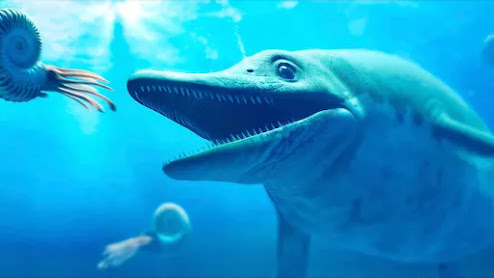Scientists believe that ichthyosaur fossils discovered high in the Swiss Alps may include the world's biggest animal.
Fossils from some of the biggest animals to ever swim the seas – whale-sized marine reptiles known as ichthyosaurs — have been discovered in an unexpected location: atop three Swiss Alps mountains rising to 2,740 metres above sea level.
Points to remember:
- The discovery of rib and vertebrae relics from two ichthyosaurs in the Swiss Alps was revealed on Thursday.
- Fossils were found in Switzerland in the 1970s and 1980s, but they are just now being formally documented.
- The fossils were discovered at the end of the Triassic Period, about 205 million years ago.
On Thursday, scientists reported rib and vertebrae remains from two ichthyosaur individuals, one measuring around 21 metres and the other about 15 metres in length.
They reported the largest-known tooth from any ichthyosaur, with a base 6 cm broad and an estimated length of 15 cm, suggesting a ferocious predator, from a third specimen.
These three individuals are among the biggest of the huge ichthyosaurs that roamed the waters at a period when dinosaurs were starting to rule the land, according to the fossils, which date to roughly 205 million years ago towards the end of the Triassic Period.
"The tooth is especially remarkable because it may represent the biggest animal to ever inhabit Earth," said University of Bonn palaeontologist Martin Sander, lead author of the research published in the Journal of Vertebrate Paleontology.
It was discovered near Davos on the Chrachenhorn mountain.
"A tooth 6 cm broad might theoretically have originated from an animal 54 metres in length," Professor Sander stated, based on the fact that an 18-metre-long ichthyosaur reported last year had a tooth with a base eight-tenths of 2 cm wide.
Two guys stand atop a mountain, gazing out over a vast mountain range that stretches far into the horizon.
The creature was likely not as massive as a sperm whale, but it was nonetheless fearsome, hunting enormous squid, large fish, and lesser ichthyosaurs.
Other large ichthyosaurs were said to be toothless and ate tiny fish and squid by sucking them up or swallowing them whole.
Giant ichthyosaurs, the world's biggest marine reptiles, with extended bodies and short heads.
Years ago, fossils were discovered.
The fossils were discovered in three locations in the eastern Alps of Switzerland in the 1970s and 1980s, according to research co-author Heinz Furrer, a retired curator at the University of Zurich's Paleontological Institute and Museum who discovered them with other geology students at the time.
For the first time, the fossils are being scientifically described.
Plate tectonics, the inevitable movement of the massive plates that make up Earth's crust, explains how fossils that developed in an ancient bottom ended up on mountains.
"The Alps have a highly convoluted structure," Professor Sanders said, "with gigantic slabs of granite made up of old sea bottom called nappes heaped on top of each other by the African plate pressing onto the European plate."
"The ichthyosaurs originate from the uppermost nappe in the pile. This accumulation occurred during the past 35 million years or thereabouts."
The bones are too fragmentary to distinguish their species, although they most likely belong to the Shastasauridae ichthyosaur family.
Shastasaurus is the most well-known ichthyosaur, with a specimen from Canada estimating a length of 21 metres.
A bemused moustached guy wields a big black long object that resembles a giant burnt-out matchstick.
Based on incomplete remains, several experts have postulated greater ichthyosaur lengths.
Giant ichthyosaurs have never been discovered so close to the end of the Triassic period.
They vanished during the Triassic mass extinction catastrophe around 201 million years ago, and no other marine species grew to the same size until baleen whales about 3 million years ago.
Icthyosaurs that were smaller existed until around 90 million years ago.
Professor Sander said, "In the history of life on Earth, there were three types of creatures that were truly giants: ichthyosaurs of the Triassic, who arrived first but are now just ghosts; long-necked sauropod dinosaurs on land; and today's baleen whales."
The blue whale, which may grow up to 30 metres in length, is the world's biggest vertebrate.
Future study on large Triassic ichthyosaurs, according to Professor Sander, may call this finding into question.



Comments
Post a Comment